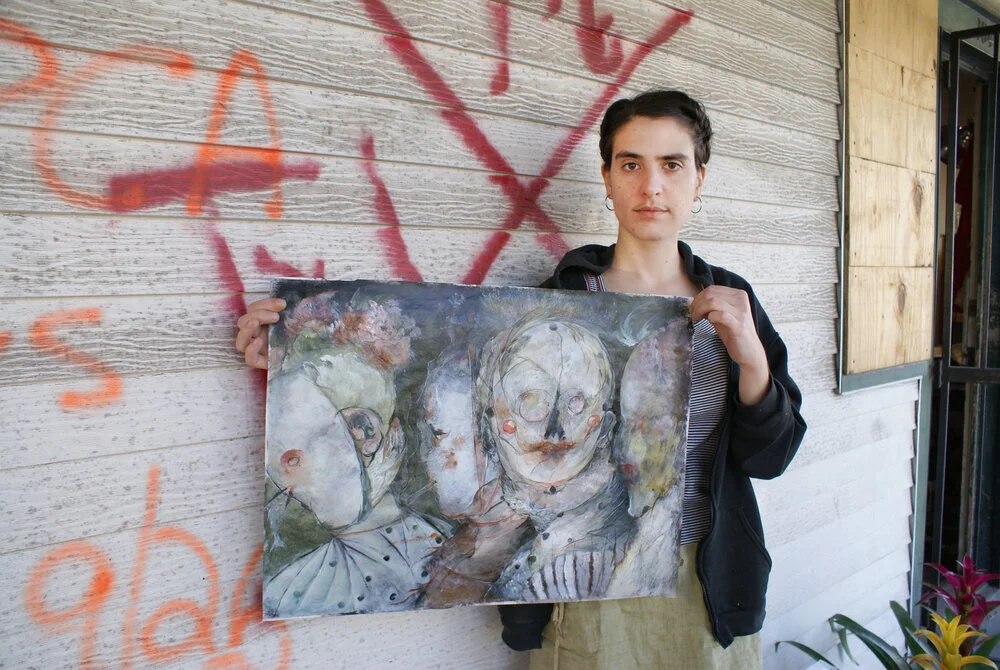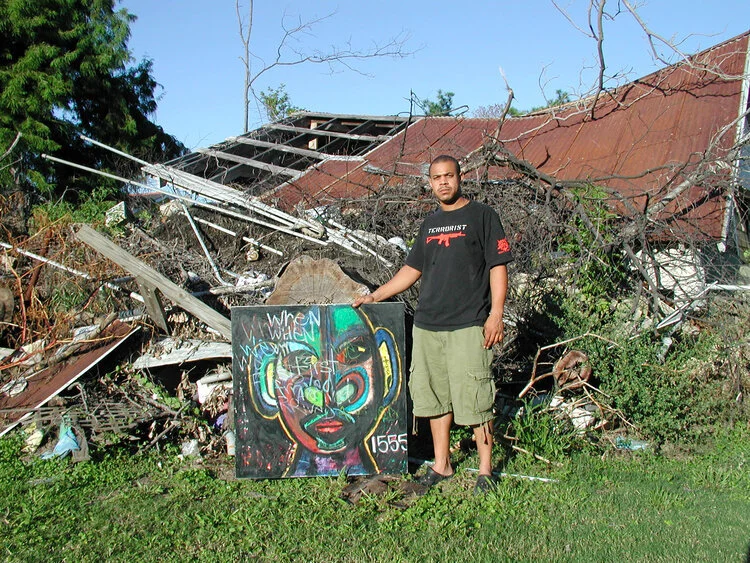Bill Sasser explores the creative legacy of Hurricane Katrina
A city known for its creative spirit, New Orleans takes a roll-of-the-dice at the start of every hurricane season. Those six months are likely to pass with languid ease, yet could always end in catastrophe. Perched on their un-solid ground by the Gulf of Mexico, New Orleanians would rather live with this uncertainty than move anywhere else. Many refused to leave for Hurricane Katrina and artists were among those hold outs, and were some of the first diehards to return after the flood.
Painter Jim LaLand was one of those who stayed through the storm. That traumatic experience left him unable to concentrate for months, until finally paying for a new roof on his house spurred him to pick up his brushes again. A self-taught artist, he usually works on sheets of clear vinyl, displayed as reserve images. Unlike a traditional painting, which builds layers on the surface of a canvas, painting on vinyl requires a more intuitive approach, he explains.
“The reason I like painting on vinyl is because I have to think about it in reverse,” says LaLand. “The first thing I paint is the first thing you’re going to see, but with canvas it’s the last thing. I paint backwards too— strange but true.”
LaLand grew up in Cajun country and his grandfather was a “traiteur,” a folk healer who communicates with the dream and spirit worlds. LaLand’s colorful, rhapsodic paintings mix images from that natural world—catfish, alligators, cypress trees, clouds and waves—with archetypal figures as saints, goddesses, and mermaids. Last year, LaLand’s vinyl paintings were part of a group show at the Art League of Long Island featuring Gulf Coast artists who survived Katrina.
(Click images for larger view - Photos by Bill Sasser)
Myrtle von Damitz had been working on two hurricane paintings before Katrina, one with mermaids lounging on the streets of a submerged gothic Atlantis, another offering an apocalyptic vision of a city being torn apart by a tempest. “A hurricane and a flood were always the big joke on everyone’s mind, always the uncertainty,” she says. Rendered with precise brush strokes and scratched lines, her oil and ink paintings are like bad dreams filled with shadowy threats and unfocused suffering. She describes them as a form of writing, “like abstracted conversations, interconnected scenes that tell a story.”
All the obstacles that come with New Orleans are what make it an interesting place to live and find inspiration, she explains. “Other cities are nice, but too, too simple. This may be the last city in the U.S. where you can live by bartering. It’s hard, but you become physically connected to it, and wheel and deal and play this mystical game and good luck comes out of nowhere.”
Amzie Adams moved to New Orleans in the psychedelic year 1969, and over the past three decades has become an underground icon of French Quarter eccentricity. A painter, silk screener, mask maker, and musician, he takes a guerilla do-it-yourself approach to life as an artist. One example: he recently traded artwork for a used car and three months rent.
“I’m a trained artist, but I’m an outsider,” says Adams. “Inside artists know people at galleries, do deals, get hooked up. Outsiders like me are living in bushes, trying to come up with something.” His paintings are vibrant, spontaneous mixes of impressionism and psychedelia, though some pieces can take darker turns. In one painting after Katrina, he created a voodoo saint as a personification of the hurricane.
(Photo by Bill Sasser)
“My idea was that change isn’t bad—things needed to change around here,” says Adams. “The schools were screwed, crime was everywhere, crack was everywhere.”
Herbie Kearney is a painter, sculptor, bone carver, and poet. Exiled in New York City after Katrina, he refused tempting offers to stay and retuned to New Orleans within weeks. Some of his artwork was destroyed by the hurricane, and two pieces were part of an exhibit of storm-damaged art at New Orleans’ Contemporary Arts Center in 2006.
With the city still in ruins, Kearney helped organize a Day of the Dead remembrance and poetry reading held in a city park where a relief camp was set up. “A lot of people died here and a lot of people left and started new lives,” says Kearney, a native of Cork, Ireland. “It was the dead I couldn’t get out of my mine and made me come back.”
For Kearney, the city is a last stand against the gentrification. “New Orleans is the last outpost against the mondo condo world for a lot of outsider artists,” he says.
(Click images for larger view - Photos by Bill Sasser)
New Orleans native Dennis Holt was 12-years-old when he joined a gang of friends “tagging” their neighborhood with graffiti. Twenty years later, he’s an accomplished multi-media artist, using tagging techniques to create provocative collage paintings. “I never took it that serious, then some of my friends’ paintings started selling for three or four thousand dollars,” says Holt, who grew up in a tough 8th Ward neighborhood. “I was like, damn—that’s the same stuff we were spray painting on buildings.”
Poetic and raw, his streetwise images mix social commentary and vibrant design. Much of Holt’s neighborhood remains vacant after flooding with ten feet of water. A neighbor recently committed suicide. But Holt resists directly turning his hurricane experience into art. “We’re still struggling like we were before—it’s the same crime rate, the same pitiful school system, the same crooked ass politicians,” says Holt. “I’m not going to vent on a house being knocked down.”
A performance artist and one-man band, Clyde Casey draws astonished crowds on New Orleans sidewalks with his Synergistic Sonic Sensor Shuttle – a ‘calliope on wheels’ that is as much a work of visual art as a music machine. Playing percussion, harmonica, xylophone and accordion, he encourages his audience to join in on pot lids, metal serving-plates and various cast-off objects. His Sensor Shuttle incorporates a magnetic chessboard, spinning fan-blades and an assortment of flashing lights. “I try to inject as much humor into everything as possible,” he explains.
Casey’s experience during Katrina was anything but humorous, though. After a forced evacuation of the city was ordered, he was knocked off his bicycle, beaten, and had a gun held to his head by state troopers. Yet still he stayed, and soon after the storm he was searching piles of hurricane trash for the ‘cosmic debris’ he used to build his current Sensor Shuttle. He also created a found-art environment in the converted greenhouse shed where he lives and works. Fascinated with the possibility of extraterrestrial life, he creates UFOs and robots from cast-off Katrina junk.
Whether it’s a hurricane or a parade,” he says. “Life is one moment turning into the next. We’re all just people bouncing off each other, creating our next moment. More than any place I’ve been, that’s what New Orleans is about.”
(Click images for larger view - Photos by Bill Sasser)












